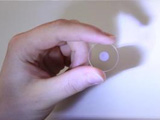|
|
TODAY.AZ / Weird / Interesting
New nanostructured glass for imaging and recording
15 August 2011 [17:00] - TODAY.AZ
 University of Southampton researchers have developed new nano-structured glass optical elements, which have applications in optical manipulation and will significantly reduce the cost of medical imaging.
University of Southampton researchers have developed new nano-structured glass optical elements, which have applications in optical manipulation and will significantly reduce the cost of medical imaging.In a paper published in Applied Physics Letters, a team led by Professor Peter Kazansky at the University's Optoelectronics Research Centre, describe how they have used nano-structures to develop new monolithic glass space-variant polarization converters. These millimetre-sized devices generate 'whirlpools' of light enabling: precise laser material processing, optical manipulation of atom-sized objects, ultra-high resolution imaging and potentially, table-top particle accelerators. They have since found that the technology can be developed further for optical recording.
According to the researchers, at sufficient intensities, ultra-short laser pulses can be used to imprint tiny dots (like 3D pixels) called voxels in glass. Their previous research showed that lasers with fixed polarization produce voxels consisting of a periodic arrangement of ultra-thin (tens of nanometers) planes. By passing polarized light through such a voxel imprinted in silica glass, the researchers observed that it travels differently depending on the polarization orientation of the light. This 'form birefringence' phenomenon is the basis of their new polarization converter.
The advantage of this approach over existing methods for microscopy is that it is 20 times cheaper and it is compact.
"Before this we had to use a spatial light modulator based on liquid crystal which cost about £20,000," said Professor Peter Kazansky. "Instead we have just put a tiny device into the optical beam and we get the same result."
Since publication of the paper in May this year, the researchers have developed this technology further and adapted it for a five dimensional optical recording.
"We have improved the quality and fabrication time and we have developed this five dimensional memory which means that data can be stored on the glass and last forever," said Martynas Beresna, lead researcher for the project. "No one has ever done this before."
The researchers are working with the Lithuanian company Altechna to introduce this technology to the market.
/Science Daily/
URL: http://www.today.az/news/interesting/92538.html
 Print version
Print version
Connect with us. Get latest news and updates.
See Also
- 05 February 2025 [19:41]
Japan plans to negotiate with Trump to increase LNG imports from United States - 23 January 2025 [23:20]
Dubai once again named cleanest city in the world - 06 December 2024 [22:20]
Are scented candles harmful to health? - 23 November 2024 [14:11]
Magnitude 4.5 earthquake hits Azerbaijan's Lachin - 20 November 2024 [23:30]
Launch vehicle with prototype of Starship made its sixth test flight - 27 October 2024 [09:00]
Fuel prices expected to rise in Sweden - 24 October 2024 [19:14]
Turkiye strikes terror targets in Iraq and Syria - 23 October 2024 [23:46]
Kazakhstan supplied almost entire volume of oil planned for 2024 to Germany in 9 months - 23 October 2024 [22:17]
Taiwan reported passage of Chinese Navy aircraft carrier near island - 23 October 2024 [21:50]
Russia remains largest oil supplier to India
Most Popular
 Foreign Ministers of China, South Korea and Japan hold meeting in Tokyo
Foreign Ministers of China, South Korea and Japan hold meeting in Tokyo
 Istanbul Airport witnesses growth in number of passenger & cargo traffic
Istanbul Airport witnesses growth in number of passenger & cargo traffic
 MÜS?AD outlines strategic steps for economic resilience
MÜS?AD outlines strategic steps for economic resilience
 The Trans-Caspian route in the mirror of Azerbaijani-Chinese relations
The Trans-Caspian route in the mirror of Azerbaijani-Chinese relations
 Armenians begged Snoop Dogg for budget money
Armenians begged Snoop Dogg for budget money
 Azerbaijan files arbitration claim against Armenia over environmental destruction
Azerbaijan files arbitration claim against Armenia over environmental destruction
 Alain vs Samvel: Circus on the wreckage of the "struggle"
Alain vs Samvel: Circus on the wreckage of the "struggle"
